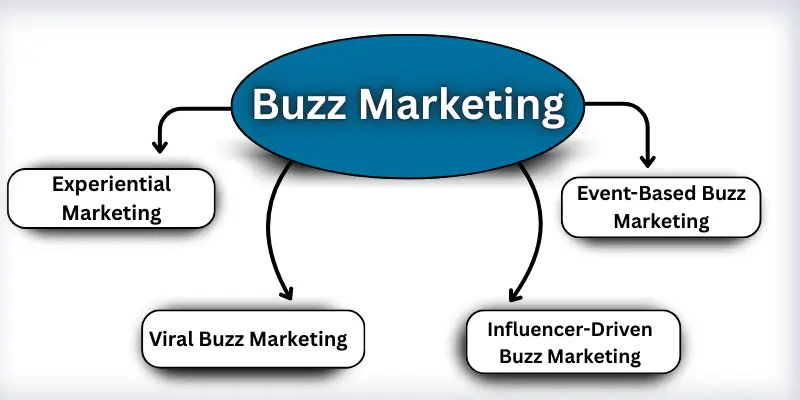Buzz marketing – Explained with Types & Examples
Published: 29 Sep 2025
Did you know that over 90% of people trust recommendations from friends and family more than traditional ads? This is exactly why buzz marketing has become one of the most powerful tools for brands today. But what is buzz marketing? Simply put, it is a strategy where brands create excitement and conversations around their products or services to get people talking naturally.

What is buzz marketing?
Buzz marketing is a marketing strategy that focuses on creating excitement around a product or service. It encourages people to talk about the brand and share their experiences with others. This approach uses word-of-mouth, social media, and viral campaigns to spread messages quickly. The main aim is to generate attention and interest naturally. In short, buzz marketing helps brands reach more people through conversations and recommendations.
Types of Buzz Marketing
Buzz marketing can be done in different ways depending on how a brand wants to create excitement and reach its audience. Each type uses unique strategies to get people talking and sharing naturally.
- Viral Buzz Marketing
- Influencer-Driven Buzz Marketing
- Event-Based Buzz Marketing
- Experiential Marketing
Viral Buzz Marketing
Viral buzz marketing happens when content spreads very fast online. People share it because it is funny, surprising, or interesting. Brands create videos, images, or posts that people love to share. The goal is to reach a large audience quickly.
2. Influencer-Driven Buzz Marketing
Influencer-driven buzz marketing uses popular people online. Brands ask them to talk about their products. Followers trust influencers and often buy what they recommend. This type helps brands reach the right audience fast. To learn more about different influencer strategies, check out our Types of Influencer Marketing guide.
3. Event-Based Buzz Marketing
Event-based buzz marketing happens at live or online events. Brands organize events to create excitement. People talk about these events and share them with friends. It makes the brand more visible and memorable.
4. Experiential Marketing
Experiential marketing lets people try or experience a product directly. Brands create fun or unique activities. Customers enjoy the experience and tell others about it. This builds excitement and strong word-of-mouth.
Advantages of buzz marketing
Buzz marketing helps brands get attention quickly and naturally. It creates excitement and makes people talk about a product or service. Here are the main advantages of buzz marketing:
| Benefits of buzz marketing |
|---|
|
Disadvantages of buzz marketing:
Buzz marketing can be very effective, but it also has some challenges. Here are the main disadvantages of buzz marketing:
| challenges of buzz marketing |
|---|
|
Buzz Marketing Examples
Buzz marketing works when brands create excitement that people love to share. Many companies use different strategies to make their products popular quickly.
Buzz Marketing Examples:
- Apple: Launches create excitement and make people talk.
- Red Bull: Sponsors extreme events that get shared widely.
- Rumors: Builds curiosity before a product launches.
- Contests and Challenges: Engage people to participate and share.
- Interactive Campaigns: Let people take part and explore the brand.
- Nike – Dream Crazier: Inspires people and spreads motivation.
- reMarkable: Shows creative demos to create interest.
- Starbucks: Seasonal drinks make fans share their experiences.
- Viral Content: Funny or interesting videos that spread fast.
- Influencer Partnerships: Influencers promote products to followers.
- Puma and Influencer Marketing: Athletes and influencers showcase products.
- Social Media Campaigns: Posts and challenges shared by people online.
How to Implement Buzz Marketing for Your Brand
Implementing buzz marketing can help your brand get noticed quickly. Follow these simple steps to start:
- Know Your Audience: Understand who likes your product.
- Choose Platform: Use social media or events your audience visits.
- Create Exciting Content: Make fun or interesting posts and videos.
- Use Influencers: Let trusted people promote your brand.
- Encourage Sharing: Run contests or challenges for people to share.
- Check Results: See what works and improve your campaign.
Conclusion
So, friends, it’s time to wrap up! We have covered what is Buzz Marketing and how it helps brands create excitement and reach more people. I personally recommend trying simple buzz marketing strategies, like contests or social media campaigns, for your own projects. Start small, be creative, and watch your ideas spread naturally. Don’t wait—begin your buzz marketing journey today!
Common Questions about buzz marketing
Yes, online stores can use buzz marketing to attract more customers. They can create shareable posts, videos, or contests. This helps products get noticed quickly.
Buzz marketing focuses on creating general excitement and conversation. Viral marketing aims for content to spread very quickly online. Buzz marketing can include viral campaigns, but it is broader in approach.
Yes, it can make your brand more popular. Exciting campaigns make people talk positively. Sharing stories and experiences builds trust with customers.
It depends on your brand and audience. Start with one or two campaigns per month. Watch how people respond and adjust your strategy.
Yes, influencers help spread the word about your products. Their followers trust their recommendations. This creates natural excitement around your brand.
Social media is usually the best platform. Facebook, Instagram, TikTok, and YouTube work well. Choose the platform your audience uses most.
Track social media shares, comments, and mentions. Check website visits and sales. This helps see how well your campaign works.

- Be Respectful
- Stay Relevant
- Stay Positive
- True Feedback
- Encourage Discussion
- Avoid Spamming
- No Fake News
- Don't Copy-Paste
- No Personal Attacks

- Be Respectful
- Stay Relevant
- Stay Positive
- True Feedback
- Encourage Discussion
- Avoid Spamming
- No Fake News
- Don't Copy-Paste
- No Personal Attacks
